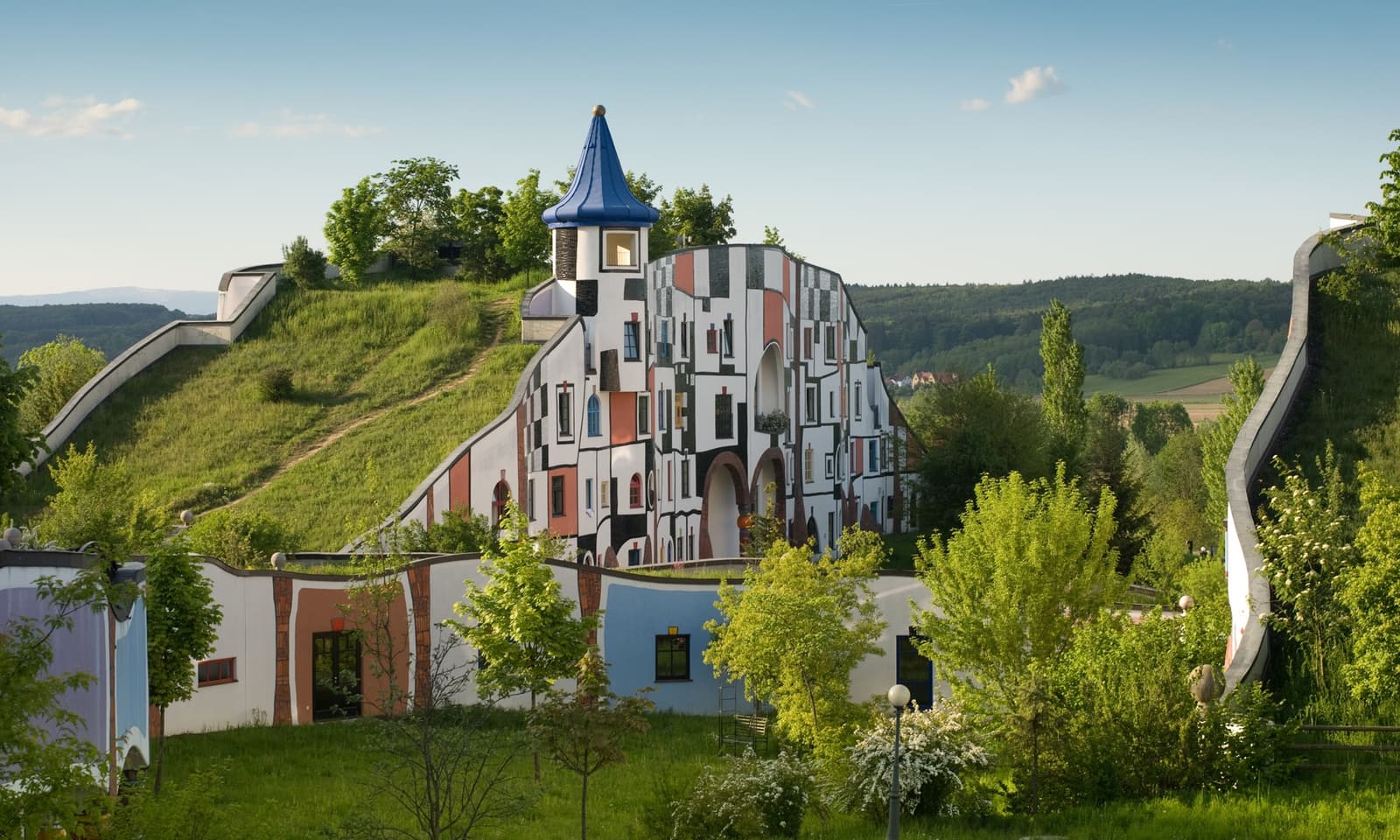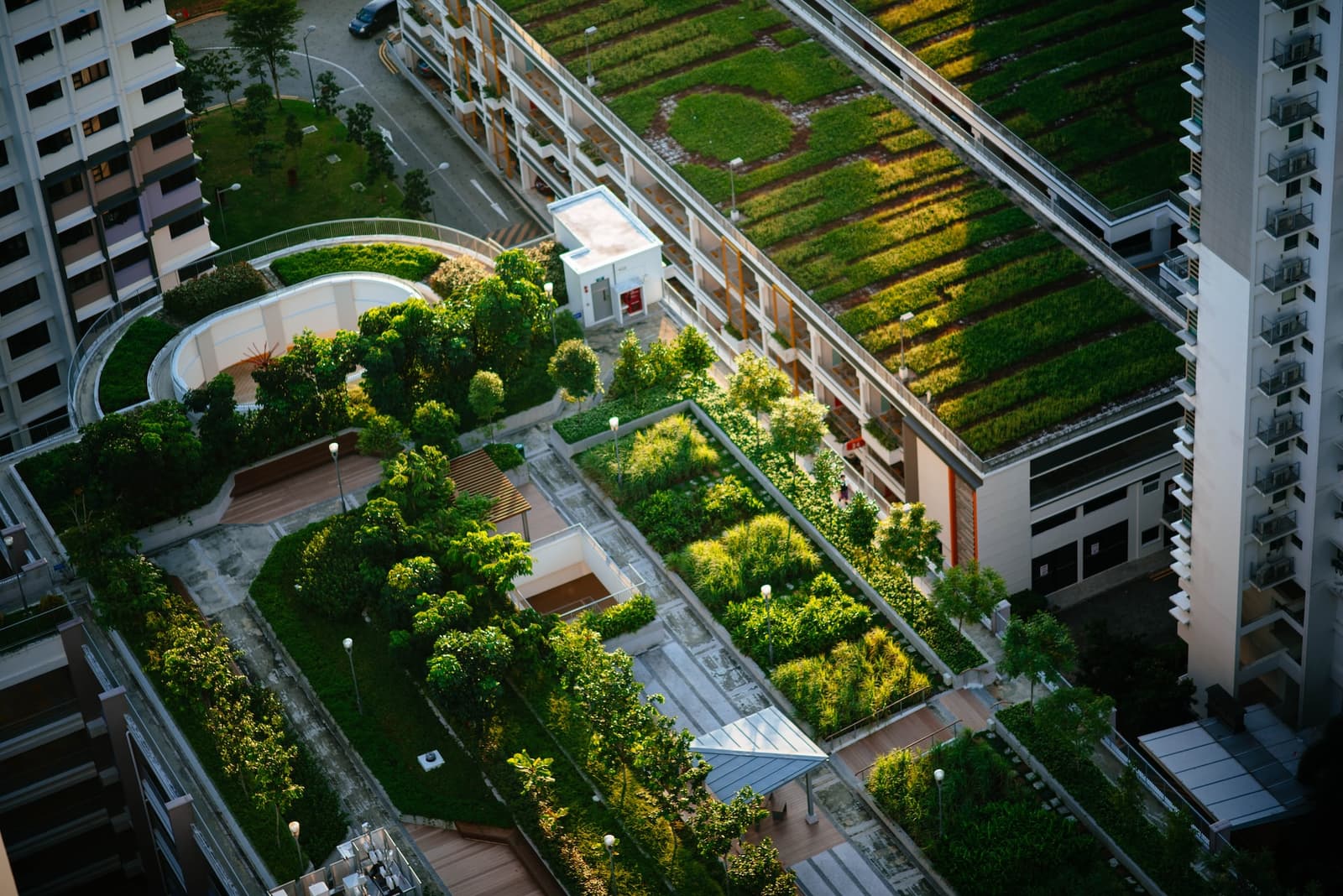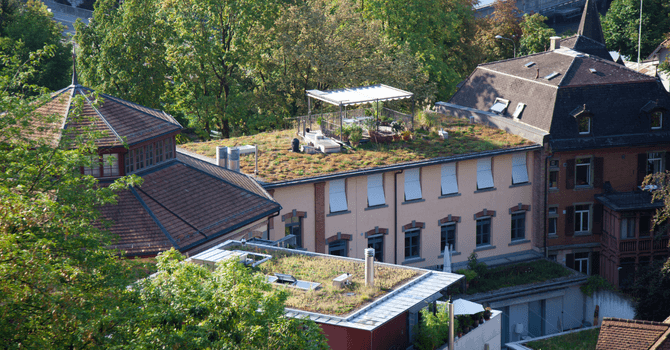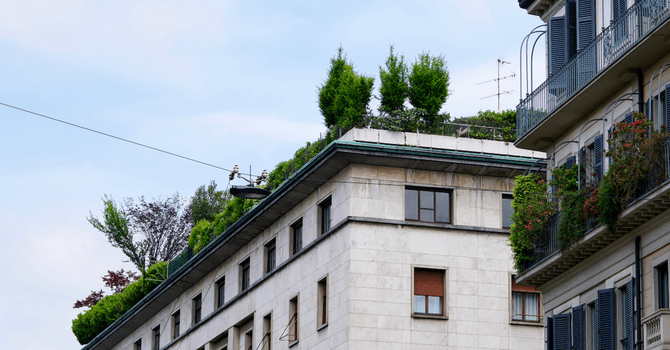
By adding a bit of greenery to your roof, you’re allowing nature to take back its course, to return where it was once unwelcomed.
As a matter of fact, the notion of what a roof should look like is changing. Merely a few decades ago, very few people would dare build a garden or a layer of greenery atop their roof.
People who were somewhat marginal, such as the Austrian artist Hundertwasser, designed buildings with amazing concepts, thus aiming to allow nature and infrastructures to coexist in complete harmony. These artists were seen as such visionaries, yet a tad peculiar because their ideas were far removed from mainstream concepts.
However, nowadays, green roofs are no longer considered eccentric. They’re an increasingly common add-on, especially given that green roofs have many advantages, including being highly eco-friendly.
Green roofs are especially valued in the city, on condo rooftops, homes, and commercial buildings, because they help dissipate heat islands. And, in the countryside, they allow nature to assume even more of the landscape by blending into buildings by way of their vegetation.
What’s a Green Roof?

A vegetated roof (more commonly referred to as a green roof) is a roof covering that's made up of several layers, the last one being vegetation (plants, flowers, fruits, and vegetables). Underneath the vegetation, there are several elements, including waterproofing membranes, which protect the building and enable the roof to serve other purposes (e.g., maintaining the temperature inside of the building).
If you're interested in learning more about this, you might be intrigued by the blue roof, which is also classified as an eco-friendly roofing system.
Components of a Green Roof
As we'll explore in the upcoming section, there are different types of green roofs, meaning that their components can vary. The following are the most common components used in making green rooftops:
Roofing frame;
Vapour barrier;
Insulation layer;
Waterproof membrane;
Root barrier;
Drain system;
Membrane filter;
One layer of substrate (soil, potting soil, organic, or mineral substrates) + vegetation.
This layering system allows vegetation to thrive on a rooftop, while also protecting the building from waterproofing issues and weather exposure.
If you're interested in flat roofs, check out these two articles:
Economic and Ecological Benefits of a Green Roof
Benefits for Property Owners
Even if the added value of a green roof doesn't necessarily translate into a financial incentive, the visual impact of a green roof alone is substantial, especially when you want to sell the building; these roofs are still quite rare, making it a distinctive feature.
Then, the roof's durability will be extended, as the membrane is protected from the elements by the layer of plants and substrate.
Ultimately, you'll save energy, since this coating also improves the roof's insulation and reduces heat loss.
Benefits for the Masses
The benefits of a green roof stretch far beyond the confines of the building. This is a particularly interesting selling point for those who care about the well-being of the planet and that of their community.
Green spaces are an asset, especially in cities. It creates a more pleasant, safer, and healthier living environment for everyone (source: INSPQ).
The substrate layer on a green roof can also absorb some level of noise, while the plants act as a high-frequency barrier, thus contributing to a quieter environment.
Green roofs can also be expected to improve stormwater management, which is an especially useful feature in urban areas. We've seen in recent years that heavy rainfalls are more frequent and drain pipes quickly fill up, causing flooding in buildings.
Any building that can support rainwater harvesting is beneficial in reducing this strain on sewer systems. Building more green roofs (and blue roofs) is definitely beneficial.
Green Roofs: The Different Types, Widths, and Features

In theory, there are three green roof models:
Extensive
This model is suitable for most structures, as it's the lightest of the three. It's also the best option for those looking for low-maintenance covering. The vegetation layer on an extensive green roof is thin (max 6 inches) and serves primarily a basic functional role.
Intensive
This one must be installed on a flat roof. It must be accessible, and have structural reinforcement, as it's extremely heavy. It also requires about 12 inches of substrate, which allows you to design a rooftop garden, including adding various types of trees and shrubs.
Semi-Intensive
If you think 6 inches is too thin, yet the intensive green roof sounds too complex, there's an in-between. This system also requires structural reinforcement, but it's less bulky than an intensive model since the components are lighter.
Tips for Building a Green Roof

Source : Canva
Types of green roof vegetation
According to Antoine Trottier, an expert landscaper at La ligne verte, “Typical examples of green roof vegetation are a combination of native grasses, but for the most part, the plants are very hardy.”
Indigenous plants: wild plants, flowers, or trees that grow naturally in specific environments.
Hardy perennials: plants that survive below zero temperatures.
Plants selected should also be able to withstand wind gusts and be low-maintenance.
Below are some examples of plants that will thrive on rooftops:
For extensive roofs
You should choose low-maintenance, drought-resistant plants, as the thin-layered substrate doesn't provide water storage for nourishment:
Aster,
Astragalus (milkvetch),
Bellflower,
Northern bedstraw,
Dalea purpurea (purple prairie clover),
Solidago (goldenrods),
Baptisia australis (blue wild indigo),
Asclepias tuberosa (butterfly weed),
Oenothera biennis (common evening-primrose),
Potentille,
Rudbeckia goldstrum (black-eyed Susan),
Silphium perfoliatum (cup plant).
(Source: Ecohabitation.)
For intensive or semi-intensive roofs
Achillea millefolium (yarrow),
Anaphalis margaritacea (pearly everlasting),
Aquilegia canadensis (Canadian columbine),
Campanula rotundifolia (harebell),
Corydalis sempervirens (rock harlequin),
Fragaria virginiana (Virginia strawberry),
Hedysarum alpinum, Houstonia caerulea (Quaker ladies),
Iris setosa var.artica (dwarf arctic iris),
Cornus canadensis,
Lychnis alpina, Mertensia maritima, Plantago maritima (sea plantain),
Potentilla pensylvanica var.litoralis (Pennsylvania cinquefoil),
Sibbaldiopsis tridentata,
Saxifraga paniculata ssp.neogaea,
Solidago nemoralis,
Triglochin maritima (seaside arrowgrass)
(Source: Aiglonindigo).
Can you DIY a green roof?
As this project could affect the structure of your home and the roof itself, you'll most likely need to get an RBQ license or hire a certified contractor to secure your permits.
As such, a DIY green roof isn't technically possible. You may be able to complete some of the steps, but in order to meet the bylaws, you'll need to adhere to the many requirements.
Dealing with a contractor specializing in green roofing
If your green roof construction project means a lot to you, then definitely team up with a specialist. Some companies have developed expertise in this field, while others build partnerships between roofers and expert landscapers.
The contractors involved will guide you through the whole project, from start to finish, helping you make the right decisions and the best choices for results that live up to your expectations. Above all, they'll help you avoid making costly mistakes if you were to DIY the work (structural problems, waterproofing, poor design, and poor choice of plants...).
Green Roof Cost Estimates
According to Antoine Trottier: "Extensive green roofs [commercial roofing, editor's note] cost between $8 to $20 per square foot." He adds that "extensive roofs [residential roofing, editor's note] cost between $15 to $25 per square foot."
A price estimate for an intensive or semi-intensive system is more complex, since structural reinforcement needs to be taken into consideration as well. However, there's no doubt that the costs are quite steep. Homeowners will save some money where energy savings are concerned, but it’s not enough to make the investment cost-effective.
Also, the value of a green roof won't increase with the value of the home, as it's considered just landscaping. However, there are many benefits other than financial perks, as well as good reasons to consider creating a green roof. We'll delve into those below.
For typical roofing costs, check out our article: Renovation Guide: Fixing Your Roof.
What kind of permits are required to build a green roof in Quebec?

Faroe Islands: Village with several green-roofed houses. Note: this type of roofing isn't permitted in Quebec according to the regulations issued by the Régie du bâtiment du Québec.
Source: Tommy Kwak - Unsplash
Even though green roofs are increasingly common, it doesn't mean that you can just go ahead and build one. It'll be important to check your municipality's bylaws (and that of your borough, if you reside in a big city) and find out exactly what, if any, special permits are required.
Some cities in Quebec don't yet have any regulations in place, which can create a lack of clarity around bylaws for this type of project. Thus, it becomes a case-by-case situation.
In the end, regardless of where you live, there are plenty of requirements to meet in order to get the necessary approvals, so it's going to be a time-consuming project.
Note that if you're planning to build a green roof on a commercial rooftop, you'll have to follow the RBQ's technical guide (French only). You’ll also have to deal with contractors who have a valid CCQ licence.
Green Roofing Terms and Conditions
According to a document published by the Régie du bâtiment du Québec (written by Claire Bélanger, architect), the following are the basic requirements for a green roof:
1.1. The building is made of non-combustible materials.
1.2. The rooftop on which the green roof is built isn't more than 46 m above normal ground level.
1.3. Roof pitch doesn't exceed 17%.
1.4. The rooftop on which the green roof is built isn't multi-layered (asphalt and gravel).
1.5. The green roof may be extensive in type (up to 150 mm thick with plant material), semi-intensive (between 150 mm and 300 mm thick with plant material) or intensive (over 300 mm thick with plant material). However, the peak height of fully grown plants can't exceed 1,200 mm, and the green roof, essentially, has to be flat; mounds or hills aren't permitted.
1.6. The local fire department has to be consulted at the planning stage of the project with respect to its specific regulations and firefighting needs.
1.7. In existing buildings, the technical criteria in Section 9 must be met, in addition to the criteria in Sections 1 through 8 of this Guide.
Consult the guide in its entirety to learn more about the technical criteria of green roofing (French only).
Green Roof Maintenance

Source : Canva
This type of roofing system requires more maintenance than most, although there's a huge difference in terms of the commitment required between an extensive and intensive green roof. The former requires relatively little regular maintenance, while the latter is more high-maintenance.
Here's a basic maintenance plan for a green roof:
Water (as needed).
Mow/trim grass.
Remove weeds.
Care for plants (fertilize, trim, remove dead leaves/plants, etc.).
And here are other steps to be taken every now and then (more frequently for intensive or semi-intensive green roofs):
Check the functionality of the drain system.
Clean the gutters (which may fill up rather quickly given the proximity to shrubs/plants).
If you want to hire someone to care for your green roof instead of doing it yourself, you can always contact landscape maintenance specialists.
You don't need to hire a roofer for a simple green roof maintenance project unless you think the structure needs to be repaired as well. Note that not all landscapers are willing to work on rooftops, but many will be happy to provide these services.
According to Antoine Trottier, “During the winter, green roofs can be left unattended. They were designed to withstand snow build-up and the weight of the green roof." This means that most of the time, there's nothing specific that needs to be done. You can ask your contractor about this, as some situations may differ from others.
The substrate which covers the surface of the roof also protects the roofing underlayments, hence increasing the durability of the membranes. We're talking about up to a 30-year lifespan.
Get 3 renovation quotes for your green renovation project
RenoQuotes.com can help you get quotes for your green renovation project. By submitting your project, we’ll put you in contact with top-rated contractors. Fill in the form on the homepage (it only takes a few minutes), and you will get estimates from trusted professionals.
Dial 1-844 828-1588 to speak with one of our customer service representatives.
Looking for something else?
Related articles
The latest industry news, interviews, technologies, and resources.

Editorial Team
•22 May 2024
The housing crisis has been a pressing issue in Ontario for several years now, with rising prices and low availability making it increasingly difficult for residents to find affordable and suitable housing. In response to this, modular homes or housing have emerged as a potential solution that could help address these challenges and provide a more sustainable and efficient way to build homes in the province.

Editorial Team
•07 Nov 2023
Homeownership almost always entails ongoing repairs, renovations, or upgrades. Note that on average, Quebecers allocate 64% of their residential energy expenditures to heating, and the costs can amount to $1,200 for an average-sized home. Surely, upgrading a heating system is a significant investment, but a wise decision in terms of energy conservation and minimizing consumption costs.

Amanda Harvey
•18 Jun 2024
Plumbing problems quickly shake up our day-to-day habits. Since we're used to having access to clean water, as soon as a situation complicates this process, many of our daily tasks are affected.

Editorial Team
•12 Aug 2025
Choosing quality windows is a must for ensuring home comfort and energy efficiency. It’s important to consider factors like window type, materials used, and manufacturer's reputation. In Quebec, brands, such as Fenplast and Vaillancourt, stand out from the lot. However, other aspects, specific to windows, such as thermal insulation and soundproofing, combined with durability, must be factored into your decision-making. Here are some must-have pointers to help you choose the right windows.

Editorial Team
•07 Nov 2023
If you want to give your love-starved backyard a little sprucing, there is nothing quite like pavers! Whether you want to create a beautiful patio or have a welcoming walkway for your guests, paving stones are definitely an integral part of many landscaping projects.